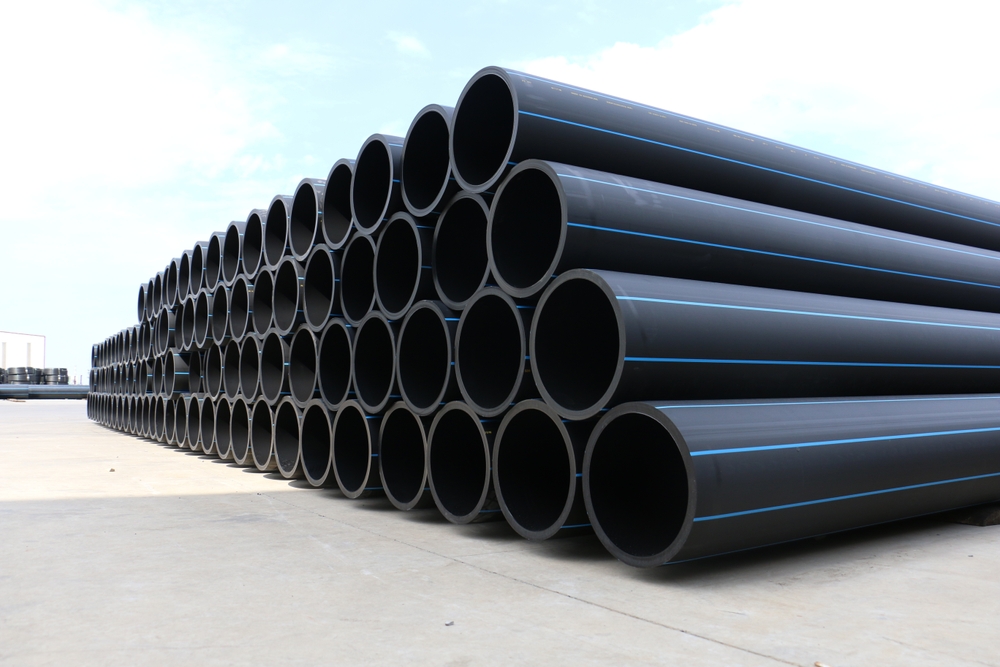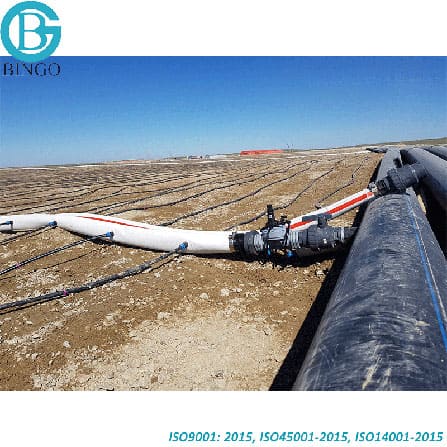Why Partnering with Pipe Supplier American Plastics Midland Ensures Timely Supply
Wiki Article
Check Out the Production Refine Behind High-Quality HDPE Pipeline and Its Applications
The manufacturing process of top quality HDPE pipelines is complex and methodical. It starts with the choice of basic materials that enhance performance. Following this, ethylene undertakes polymerization to create resin, which is after that formed with extrusion. Quality control is paramount, making certain that the final item satisfies rigorous standards. The journey of HDPE pipelines does not end with production. Their applications across numerous industries expose a more comprehensive significance worth taking a look at.Recognizing HDPE: Characteristics and Advantages

High-density polyethylene (HDPE) is a versatile thermoplastic recognized for its longevity and resistance to numerous environmental aspects. This product exhibits excellent tensile strength, making it ideal for requiring applications. Its low-density structure adds to a light-weight item, helping with simplicity of managing and setup. HDPE likewise showcases exceptional resistance to chemicals, which decreases destruction when exposed to extreme compounds.
The product's low moisture absorption further boosts its longevity, making it ideal for usage in pipes and tank. Additionally, HDPE is resistant to ultraviolet (UV) radiation, guaranteeing that items maintain their integrity also when revealed to sunshine. Furthermore, its versatility permits the development of complex forms without compromising toughness. The environment-friendly nature of HDPE, often obtained from recycled products, includes to its charm, advertising sustainable methods in manufacturing. In general, these properties and advantages make HDPE a recommended option for various industrial and customer applications.
Raw Product Selection for HDPE Manufacturing
The selection of basic materials for HDPE manufacturing is vital to confirm the final item meets the wanted specifications and top quality requirements. High-density polyethylene (HDPE) is mainly produced from polymerized ethylene, stemmed from fossil fuels such as all-natural gas or crude oil. The top quality of these feedstocks significantly affects the mechanical and thermal buildings of the last HDPE.Additives likewise play a considerable function in enhancing HDPE's performance, including antioxidants, UV stabilizers, and colorants, which improve sturdiness and resistance to ecological factors. The selection process should think about not just the chemical make-up of the raw materials yet likewise their handling qualities to guarantee reliable production.
The sourcing of raw materials must focus on sustainability and compliance with environmental policies, as accountable methods are necessary in today's market. Ultimately, cautious raw material option lays the structure for producing premium HDPE pipes ideal for diverse applications.
The Extrusion Refine: Forming HDPE Pipe
The extrusion procedure plays a crucial function in forming HDPE pipelines, starting with careful material prep work strategies that ensure suitable flow and uniformity. Just as crucial is the design of the die, which straight affects the last dimensions and surface area high quality of the pipe. Together, these aspects contribute considerably to the performance and top quality of HDPE pipe manufacturing.Product Preparation Techniques
Effective production of HDPE pipes begins with precise product prep work strategies, especially the extrusion process. During this phase, high-density polyethylene resin is first dried to remove moisture, guaranteeing perfect flow attributes. The resin is then fed into the extruder, where it undergoes heating and melting, changing into a viscous state. This heating procedure is very carefully regulated to keep the material's integrity and efficiency. The molten HDPE is compelled through a die, shaping it right into a constant pipeline kind. Proper temperature administration throughout extrusion is necessary, as it directly impacts the material's residential properties and the end product quality. Once shaped, the HDPE pipeline is cooled and cut to specified lengths, ready for subsequent processing and applications.Die Style Importance
Accuracy in die design plays a crucial role in the extrusion process of HDPE pipes. The die works as the last shaping device, straight affecting the pipeline's measurements, wall thickness, and surface finish. A well-designed die assurances consistent material circulation, reducing defects such as abnormalities and weak points. The geometry of the die have to be maximized to fit the details homes of HDPE, including its thickness and thermal habits during extrusion. Additionally, the cooling price of the product as it travels through the die can markedly affect the pipeline's structural integrity. Subsequently, buying advanced die modern technology is crucial for makers aiming to generate premium HDPE pipes that fulfill market standards and customer assumptions.Top Quality Control Actions in HDPE Manufacturing
Although numerous aspects affect the high quality of HDPE pipeline manufacturing, efficient high quality control actions are critical to ensure uniformity and dependability in the last product. Key top quality control methods consist of extensive product assessment, confirming that the raw polyethylene fulfills well-known criteria for purity and density. During the extrusion process, parameters such as temperature level, stress, and cooling time are closely kept an eye on to keep dimensional accuracy and structural stabilityAdditionally, post-production testing is crucial; manufacturers typically conduct hydrostatic examinations to analyze the pipeline's stamina and resistance to stress. Visual evaluations for surface flaws additionally enhance quality guarantee. Qualification from relevant criteria organizations, like ASTM or ISO, supplies an extra layer of reliability. By executing these complete high quality control measures, makers can reduce problems, improve efficiency, and guarantee that the HDPE pipelines fulfill the certain demands of numerous applications, inevitably resulting in customer satisfaction and trust in the product.
Applications of HDPE Pipe Throughout Industries
HDPE pipes are made use of across various sectors as a result of their durability and convenience. In water distribution systems, they assure effective delivery, while in wastewater administration, they supply reputable remedies for waste transport. Additionally, farming irrigation networks gain from HDPE's resistance to corrosion and flexibility, making it an optimal selection for contemporary farming techniques.
Water Circulation Equipments
A substantial number of sectors rely upon high-density polyethylene (HDPE) pipelines for efficient water circulation systems. Known for their durability and resistance to rust, HDPE pipes are widely made use of in community water supply networks, farming irrigation, and commercial applications. Their lightweight nature assists in simple handling and setup, reducing labor expenses and time. In addition, HDPE pipes can suit different stress levels, making them appropriate for both low and high-pressure systems. American Plastics HDPE Pipe Manufacturing. The flexibility of the product allows for smooth assimilation right into existing framework, minimizing the need for extensive excavation. Furthermore, HDPE's resistance to chemical leaching guarantees that the water supplied stays secure and tidy, making it an excellent selection for preserving the quality of drinkable water throughout various industriesWastewater Management Solutions
Efficient water distribution systems likewise lead the method for innovative wastewater monitoring remedies, where high-density polyethylene (HDPE) pipes play a considerable role. Distinguished for their resilience and resistance to corrosion, HDPE pipes are perfect for moving wastewater in different setups. Their versatility permits for very easy setup in complex atmospheres, minimizing the requirement for comprehensive excavation. Additionally, HDPE's smooth interior surface area decreases friction, enhancing circulation prices and effectiveness. These try this site pipes are additionally immune to chemical leaching, making sure that contaminants do not endanger the surrounding atmosphere. Industries, towns, and therapy facilities significantly count on HDPE pipes for their integrity and longevity, making them a favored selection for modern wastewater management systems. This flexibility highlights the critical value of HDPE pipelines throughout various applications.Agricultural Irrigation Networks
Agricultural irrigation networks benefit greatly from the use of high-density polyethylene (HDPE) pipelines, which give reliable and dependable water shipment to plants. HDPE pipes are lightweight, making them simple to deliver and set up, while their adaptability permits different setups in diverse terrains. These pipes demonstrate excellent resistance to corrosion, chemicals, and UV radiation, guaranteeing toughness in extreme agricultural environments. Furthermore, their smooth interior surface minimizes friction loss, optimizing water circulation and reducing energy prices connected with pumping. The longevity of HDPE pipes, frequently going beyond 50 years, adds to reduce upkeep and replacement expenditures. Subsequently, farmers increasingly count on HDPE pipelines to improve irrigation efficiency and promote lasting agricultural practices, inevitably causing enhanced crop returns and resource conservation.Future Fads in HDPE Pipe Innovation
As the demand for lasting and effective infrastructure expands, advancements in HDPE pipeline technology are positioned to transform numerous sectors. Arising fads consist of the integration of wise technologies, such as sensors and IoT capacities, which assist in real-time tracking of pipe problems, decreasing upkeep costs and protecting against leaks. Additionally, the advancement of sophisticated production methods, such as 3D printing, is allowing the production of complicated, customized pipe styles that accommodate details task requirements.The focus on recycling and round economic climate practices is driving the advancement of HDPE pipelines made from recycled products, enhancing sustainability. Enhanced jointing approaches, such as electro-fusion and mechanical installations, are additionally improving setup effectiveness and integrity. The expanding focus on ecological laws is pushing manufacturers to adopt greener production procedures, making certain that HDPE pipes not just fulfill market requirements yet additionally foster a more sustainable future for framework growth.
Regularly Asked Concerns
How Does HDPE Compare to Various Other Plastic Materials?
HDPE outshines lots of various other plastic materials relating to longevity, chemical resistance, and adaptability. Its low thickness and high tensile toughness make it optimal for different applications, typically surpassing options in both efficiency and longevity.What Are the Environmental Effects of HDPE Manufacturing?
The ecological effects of HDPE production consist of greenhouse gas discharges, energy usage, and prospective pollution from making processes. In addition, improper disposal can bring about dirt and water contamination, raising problems regarding lasting environmental results.Can HDPE Pipes Be Recycled?
Yes, HDPE pipes can be recycled. Many centers accept utilized HDPE for handling, transforming it right into new products. This recycling adds to sustainability efforts, lowering plastic waste while preserving resources and energy in the production cycle.What Is the Life-span of HDPE Pipes?

How Do Temperature Level Variations Impact HDPE Pipe Efficiency?
Temperature level variations substantially influence HDPE pipeline performance, influencing adaptability and toughness. Heats can bring about softening, while low temperatures may cause brittleness, ultimately affecting the pipeline's durability and suitability for numerous applications in varied environments.Report this wiki page